The MAO-A gene, popularly nicknamed the “warrior gene,” produces the enzyme monoamine oxidase A (MAOA). It breaks down monoamine neurotransmitters (dopamine, epinephrine, and serotonin) through oxidation. Thus, mutations in the MAO-A gene can directly affect the levels of these neurotransmitters, potentially leading to various behavior-associated disorders. How much influence does this gene have on your personality?
MAO-A is an essential regulator of brain function and is highly expressed in the brain and heart cells. It mainly assists in the breakdown of neurotransmitters such as
Because MAO-A regulates the level of these “behavioral hormones,” too little or too much of this enzyme plays a role in several psychiatric and neurological disorders like schizophrenia and ADHD.
A class of drugs that inhibit this enzyme (MAOA inhibitors) is prescribed to treat depression.
We all have the MAO-A gene but carry different versions (or types or variants) of it.
Based on the number of times the sequence of the gene is repeated, there are two types of MAO-A genes: a high-activity (MAOA-H) and a low-activity (MAOA-L) type.
One of the most frequently studied variants is MAOA-4R, which has four repeats associated with high MAO-A enzyme activity.
Other forms of MAO-A include the 2-repeat (2R) and 3-repeat (3R) versions.
Monoamine oxidase A deficiency follows an X-linked inheritance pattern, primarily affecting males.
Lower levels of MAO-A typically result in the buildup of neurotransmitters in the brain.
This buildup manifests as unusual behavioral patterns involving aggressive outbursts and abnormal sexual behavior.
A deficiency of MAO-A has also been associated with abnormal brain development, which can directly lead to intellectual disabilities.
Lower levels of the enzyme result in a slower breakdown of the neurotransmitters, while higher levels of the enzyme equal a faster breakdown.
Lower and higher enzyme levels are popularly associated with ‘worrier’ and ‘warrior’ personalities, respectively.
Such differences happen through mutations at specific points in the gene sequence, known as RSIDs.
At a specific point, the sequence’s usual allele may be A, and this state of the sequence may be associated with some amount of risk for a given trait.
If a mutation occurs, and the allele at that point is now C, this state of the sequence may be associated with a higher or lower risk for that trait.
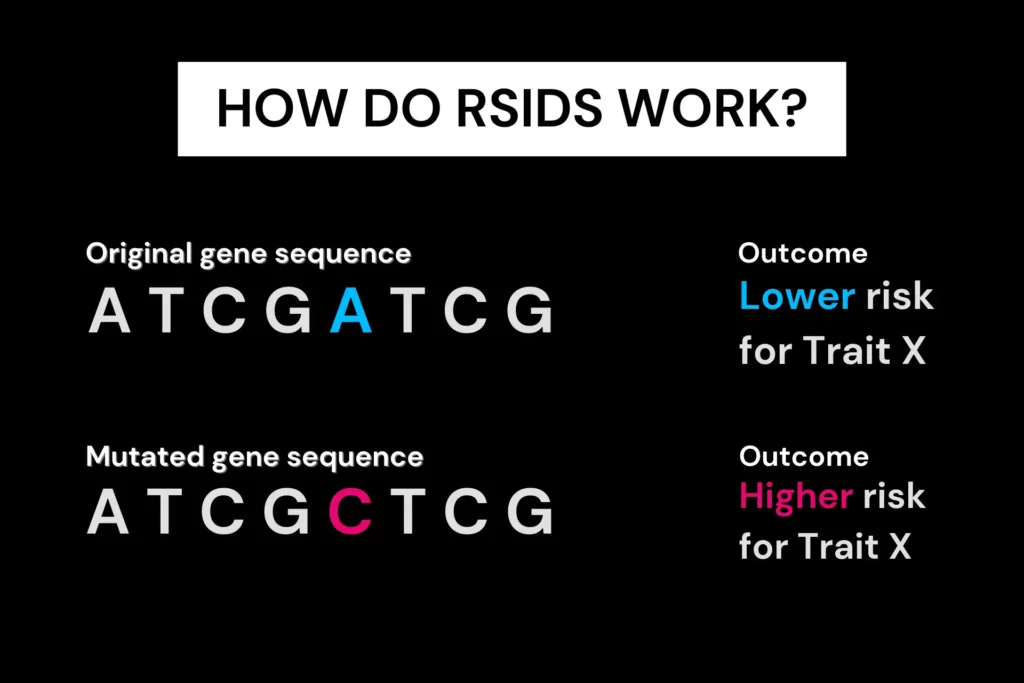
A study on around 18,000 people with psychiatric issues identified an SNP rs1137070 associated with major depressive disorder and schizophrenia.
People with the T allele had higher enzyme levels and, as a result, lower levels of the neurotransmitters.
Another study found that the G allele of rs6323 had the highest expression of the MAOA enzyme.
Subjects with major depressive disorder had the highest activity form of the enzyme (G or G/G).
A study identified an SNP rs3027407 on the MAO-A gene associated with ADHD.
This SNP affects dopamine-mediating action, which is related to the symptoms of ADHD in children. The A allele is more frequent in people with ADHD.
The T allele of rs909525 in the MAO-A gene is associated with less aggressive behavior due to the higher activity of MAOA - the warriors.
The C allele is associated with more aggressive behavior.
A variation in the MAO-A gene was associated with higher levels of anger being expressed. The A allele of rs2064070 was also associated with increased anger expression.
This study also confirmed that mutations in rs909525 and rs6323 have links to increased anger expression, as mentioned previously.
| RSID (variation) | Expressed allele | Likely outcome |
| rs1137070 | T | Lower neurotransmitter levels |
| rs6323 | G | Poor temper, risk of depressive disorders |
| rs3027407 | A | Increased risk for ADHD |
| rs909525 | T | Less aggressive behavior |
| rs909525 | C | More aggressive behavior |
| rs2064070 | A | Increased anger expression |

While the MAO-A gene helps regulate your neurotransmitters (thereby affecting your mood), the relationship between genes and your behavior isn’t entirely straightforward.
The COMT gene also helps regulate dopamine levels, contributing to your ‘warrior/worrier’ personality.
Mutations in the COMT gene also influence your creativity and impulsivity levels.
Xcode Life’s Traits And Personality Report studies the COMT variations you carry, revealing more information on the genetic aspects of your personality.
It also provides genetic results for the Big 5 traits, leadership, empathy, cognition, and more.
A study found that a poor-quality diet during adolescence can affect the verbal ability of individuals with a low expression variant of the MAO-A gene.
People who rarely ate vegetables and consumed more junk food had verbal deficits in early adulthood.
The “psychopathic” personality traits were also observed more in subjects who frequently consumed fast foods during their adolescence - this was seen only in people with a low expression variant of the MAO-A gene.
MAOA inhibitors (MAOA-I) are a class of drugs that lower the enzyme MAOA levels. Higher MAOA levels have been linked to conditions like depression.
When on MAOA-I, it is crucial to limit high-tyramine foods. Tyramine is an amino acid that helps regulate blood pressure. MAOA enzyme is required to break down tyramine, the buildup of which is associated with migraines and life-threatening blood pressure spikes.
If you are on MAOA-I, it is vital that you reduce your tyramine consumption.
Some foods high in tyramine are:
Everyone carries the MAO-A gene.
What differs among a population is the allele that is expressed, leading to either a ‘warrior’ or a ‘worrier’ personality.
The exact mechanism behind personality is more complex, but it’s essential to understand that everyone has the MAO-A gene and expresses it differently.
While the SNPs linked to MAO-A have links to increased aggression and anger expression, the link between genes and personality is far too complex.
Lesser MAO-A does affect how your neurotransmitters function, but other factors, like your immediate environment and circumstances, also affect your overall aggression levels.
MAO-A is an X-linked gene, and men only have one X chromosome.
Together, this means that the presence of one copy of MAO-A leads to its complete expression in men.
What differs is the level of its expression.
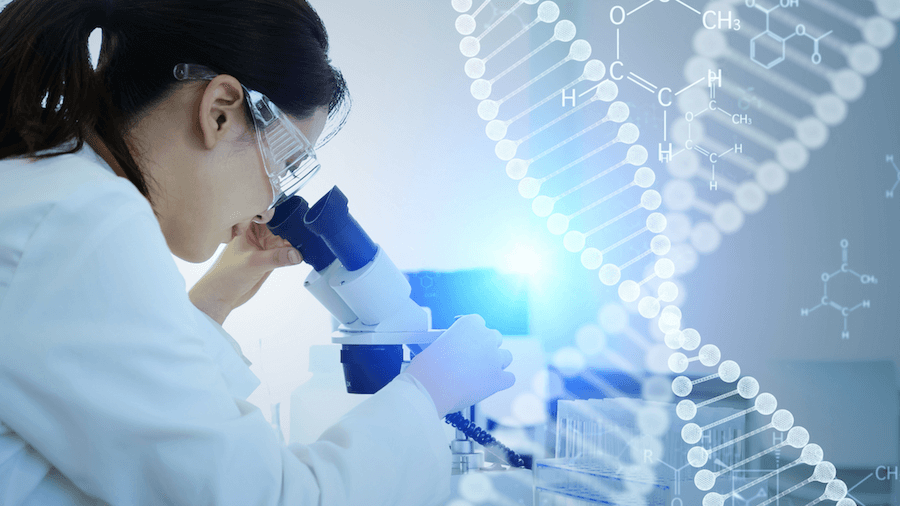
What Is COMT Gene Mutation?

How To Deal With A Slow COMT Gene

Which Parent Carries The Autism Gene?
For a long time, the only treatment for tooth decay was an extraction. Drilling out the decayed part and filling it with a filling material was another possible treatment option. A root canal treatment (RCT) is one of the most popular treatments for tooth decay since this procedure can save your tooth. However, did you know you can naturally reverse tooth decay without getting it filled or an RCT? In this article, we tell you why it might be possible and how you can do it.
Tooth decays are some of the most common dental problems in children and adults.
Food debris clings to your teeth when you don't rinse or brush your teeth after a meal.
Bacteria present in your mouth feed on these food debris and produce acids.
These acids erode the enamel, the outermost layer of your teeth, and result in tooth decay.
Here is an overview of the stages of tooth decay:

Oral hygiene habits and several medical conditions can lead to tooth decay.
Here are a few causes of tooth decay:
In the initial stages, you will not notice any symptoms of tooth decay.
However, as the decay progresses and reaches deeper layers of your teeth, you will start to notice symptoms.
If you catch tooth decay early enough, it is possible to reverse it.
Using fluoride gels on the affected area and maintaining a proper oral hygiene routine can reverse early-stage cavities.
Here are the top 3 at-home methods to reverse early-stage tooth decay:
One of the most common treatment options for tooth decay is to have your dentist drill your teeth to remove the infected part. Then, the cavity will be filled with a tooth-colored filling material or silver amalgam to prevent the infection from spreading further.
If tooth decay has damaged the tooth structure, inlays and onlays can be used to repair it. An inlay will cover all the pits and fissures of the tooth being repaired, while an onlay will cover a larger area and involve all the tooth's cusps.
When tooth decay reaches the pulp, a root canal is recommended. Endodontists are dentists who specialize in this procedure. They remove the pulp from the infected tooth and fill it with gutta-percha, a root-filling material. The treated tooth is then covered with a crown.
If the decayed tooth has been damaged beyond repair, your dentist will recommend an extraction to remove the tooth from the socket. Your dentist will remove the infected tooth under local anesthesia during an extraction. You can get artificial teeth or implants to replace the tooth.

You can stop tooth decay before the demineralization process has started.
This means you can reverse tooth decay when it has only affected the surface levels of the enamel.
If you use fluoride toothpaste at this stage, you can remineralize the decayed area and prevent the infection from spreading further.
Once the tooth decay has reached the dentin and formed a hole in the teeth, it cannot be reversed anymore.
When the outer enamel layer gets destroyed, you have to visit a dentist to get it treated.
A good oral hygiene routine will help prevent tooth decay.
Here are a few important steps to maintain a proper oral hygiene routine:
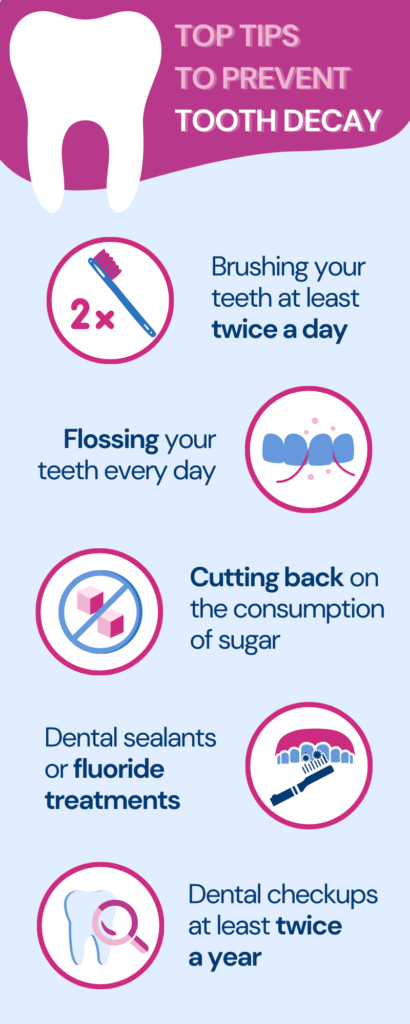
You should visit your dentist when you notice visible holes and spots on your tooth.
Chances are, you will also experience an accompanying toothache.
Other signs of tooth decay are:
Tooth decay is one of the world's most common oral health problems.
When caught early on, tooth decay can be reversed.
This can be done by remineralizing the area of the tooth destroyed by bacteria.
However, this will only be possible if the decay is superficial and hasn't yet reached the deeper layers of the tooth.
The best way to prevent tooth decay is to brush your teeth twice a day, floss before bed, and get checked by a dentist every six months.

Bad Teeth Genes: Can Dental Issues Run In Families?

Improve Your Dental Health For A Better Mental Health
https://www.nidcr.nih.gov/health-info/tooth-decay/more-info/tooth-decay-process
https://www.nidcr.nih.gov/health-info/tooth-decay
https://www.cdc.gov/nchs/fastats/dental.htm
https://pmc.ncbi.nlm.nih.gov/articles/PMC10799546
Muscle power and endurance are terms used while describing or setting up a workout routine. They sound interchangeable, but they’re different attributes of muscular health. Understanding these differences is an essential component of a healthy exercise routine. Not everyone needs the same workout, though. Some people naturally have better muscle power, and others have more endurance. Does genetics have something to do with it? Or is it just a matter of lifestyle and environment? Let’s find out!
According to the American Council on Exercise (ACE), muscle power is the ability to move weight quickly.
It can also be defined as the ability to exert maximum force in minimal time.
Muscle power requires fast-twitch muscles that contract quicker but tire sooner.
These muscles are used for sprinting, jumping, weight lifting, track and field, boxing, and football.
Muscle endurance is the ability to repeatedly perform one movement over a period of time.
According to the ACE, here are a few benefits of including muscle endurance training in your workout routine:
Consistency and stamina are two key characteristics of muscle endurance.
Slow-twitch muscle fibers contract slowly but can work for a long time without tiring.
These fibers enable endurance activities like marathon running and repetitive, rhythmic exercises like weighted squats.
| Muscle Power | Endurance | |
| Force vs. duration | It is the application of large forces in short duration | It is the application of low to moderate force sustained over a period of time |
| Muscle fiber type | Fast-twitch fibers (Type II) are predominant in power activities | Slow-twitch fibers (Type 1) are dominant in endurance activities |
| Energy system utilized | Since the movement required is quick, muscle power uses anaerobic energy systems like ATP-PC and the glycolysis pathway | Endurance requires sustained movements over a period of time; the muscles require oxygen and depend on aerobic energy systems |
| Genetics and muscle fiber composition | The 577RR variant of the ACE gene is associated with a high proportion of fast-twitch fibers and is seen more commonly in athletes who rely on muscle power. | The 577XX variant of the ACE gene is more common among high-performing endurance athletes. |
Athletic performance and training can be designed according to the individual’s muscle composition.
Let’s look at some aspects of training for muscle power and endurance.
Working out is one of the most effective ways to boost muscle power.
A few helpful exercises include:
To ensure your muscle power training is safe and effective, here are a few things to keep in mind:
These practices help keep both types of muscle fibers healthy, promoting overall muscle fitness while minimizing the risk of pain or injury.
Cardio is an effective way to improve muscular endurance and build your stamina.
It helps build the body’s lactic acid system, allowing it to sustain muscular contraction for longer.
A few examples of cardio activities that can help build muscular endurance include:
Muscular exercises that use body weight and target specific body muscles are another way to improve endurance.
A few examples of exercises that use body weight include:

Though the muscular ability of individuals varies, balancing muscle power and endurance offers a well-rounded fitness journey.
It allows one to easily perform everyday activities, reduces the risk of injury, and optimizes athletic performance.
Muscle strength and endurance are both muscle abilities, and neither is better than the other.
However, depending on your fitness goals, one may be better suited for you than the other.
While muscle strength requires short, intense bursts of energy, endurance is recommended for activities needing sustained effort, such as distance running or swimming.
For overall fitness, a balance of both is recommended.
To boost muscle power and endurance, you must train for them together.
It’s best to achieve a balance between muscle power and endurance in your everyday life.
Powerlifting involves lifting a large weight once with an emphasis on speed and power.
Endurance lifting involves lifting lighter weights multiple times with an emphasis on rhythm and stamina.
Both these types of weight lifting are aimed at developing different muscular fibers and abilities.
Two tests are used for muscular power– the broad jump test and the vertical jump test.
This test is used to measure the muscular power of the legs.
Stand with your feet slightly apart, jump as far ahead as possible, land steadily on both feet, and measure the distance between where you started and where you landed.
The average of three attempts is a good indicator of your muscular power.
This is a common test used to measure the muscular power of an individual’s lower body, especially their ability to jump vertically.
Stand facing a wall or some vertical measuring device with your feet shoulder-width apart and hands on your hips. Jump straight up as high as possible, landing at the same spot you jumped from.
The average of three attempts is a good indicator of your lower body’s muscle power and performance in volleyball, basketball, and track and field.
Powerlifters target maximum strength and power at the expense of endurance.
On the other hand, bodybuilders train to gain muscle size and may have moderate endurance due to higher-rep training.
So, bodybuilders may have slightly better endurance while lifting weights due to their training style.
Powerlifters show better raw strength.
In addition to fitness training and diet, you can opt for supplements that may help with power and endurance build-up. These include:
Beetroot juice and iron-rich foods in your diet can also help with muscle power and endurance training.
Always consult a healthcare professional before starting a supplement regimen.

Is DOMS A Sign Of Muscle Growth?

What Vitamin Stops Age-Related Muscle Loss?

Reviewing The Most Popular Diets Of 2024
We often hear that acne is just a teenage problem that will fade away with adulthood. However, for many, acne remains a persistent issue well into their twenties and thirties. When dealing with acne, what you put on your plate matters as much as what you put on your face. While sugary and oily foods are known culprits, eggs have also come under scrutiny. Despite being a nutritional powerhouse, some worry that the hormones in eggs, such as albumin and progesterone, might trigger acne. In this article, we explore whether eggs can cause acne and how you can maintain healthy skin through smart dietary choices.
Eggs, in particular, have been under scrutiny.
Some sources suggest that eggs may contribute to acne due to the presence of hormones like progesterone and substances such as iodine, biotin, and albumin.
These components are known to be potential acne triggers for some individuals.
While eggs contain hormones that can influence sebum production, a key factor in acne development, the extent to which they affect individuals can vary greatly.
Some may find that consuming eggs worsens their acne, while others may not notice any change.
Eggs are a rich source of nutrients, providing high-quality protein, vitamins, and minerals. However, certain components within eggs have been identified as potential acne triggers:
Consuming egg whites, which contain the protein albumin, might trigger an inflammatory response in people with egg allergies or sensitivities. This response could potentially contribute to facial inflammation and acne.
Eggs contain small amounts of hormones like progesterone. While theoretically possible, these trace amounts are unlikely to significantly disrupt hormonal balance and lead to acne in most people.
Eggs contain iodine, but the amount is unlikely to be a significant factor for acne development in most individuals.
Eggs are rich in biotin, a vitamin B important for skin health. However, high biotin intake might interfere with the absorption of other B vitamins involved in oil regulation. This could contribute to acne in some cases, but more research is needed.
It's important to remember that these components don't necessarily cause acne in everyone. The impact of eggs on acne varies greatly between people. Factors like genetics, overall diet, and skin type play significant roles.
The science on eggs and acne isn't black and white, so neither whites nor yolks are a guaranteed culprit. Here's an analysis of the potential factors:
While eggs offer valuable protein and vitamins, certain components might worsen acne for those sensitive to particular ingredients.
Here's why eggs could be problematic for some:
It's crucial to note that scientific understanding in this area is still evolving, and the impact of diet on acne varies significantly among individuals.
The decision of whether or not to eliminate eggs from your diet should be taken only after consulting a qualified dermatologist.
Egg allergies can lead to various skin problems that can disrupt your daily routine. Here's how eggs can affect your skin health:
Did You Know? Certain genes can increase your risk for acne. They influence oil production and inflammatory response. Xcode's Gene Skin panel uncovers your risk for acne and provides comprehensive insights into overall skin health.
*reports are generated only using existing ancestry test DNA data. xcode does not ship out DNA kits
Recent research highlights the possibility of dietary factors influencing acne in some individuals, shedding light on potential triggers to be aware of:
Studies suggest a link between milk consumption, especially during teenage years, and worse acne. Milk might mess with hormones like insulin and IGF-1, worsening breakouts.
It's crucial to note that diets high in fast food, characterized by sugary, greasy, and processed foods, have been linked with increased acne. This type of eating can disrupt your body's hormones and genes, potentially causing breakouts.
Researchers have yet to answer whether chocolate directly causes acne. Some recent studies suggest a connection, but why and how strong it is remains a mystery.
Some worry that the amino acids in whey protein powders might make skin cells grow too fast and clog pores. Also, the effect of whey protein on hormones needs more investigation regarding acne.
Since acne involves inflammation, foods you're sensitive to might worsen breakouts. An elimination diet with a doctor's help can reveal your personal trigger foods.
Here are some approaches you can consider to potentially incorporate eggs into your diet while minimizing the risk of acne breakouts:
Here are 5 foods that may be beneficial for preventing acne:
Those prone to inflammatory responses and sensitive to hormonal changes may have a higher risk of developing acne due to the albumin and hormones present in eggs.
Eggs do have certain nutritional components like protein, B vitamins, and selenium, all of which benefit skin health. However, individual responses to eggs vary.
Many food and food groups can trigger acne. Some of them are: processed food, sugary foods, dairy, and alcohol.
Foods rich in omega-3 fats (like walnuts and salmon), antioxidants (like berries and greens), lean protein (like poultry and tofu), and low glycemic foods can help with acne.
Cottage cheese and other dairy products have been associated with acne. Although there's no direct link, it can aggravate acne and also may trigger acne in those who are predisposed to it.
While eggs are nutritious, some components, such as albumin, hormones, iodine, and biotin, may trigger acne in some people based on genetics, diet, and skin type.
Egg allergies can result in skin problems such as inflammation, hives, and aggravated eczema.
Dairy, fast food, chocolate, whey protein, and food sensitivities are other potential dietary acne triggers.
To reduce acne risk when consuming eggs, try moderate intake, alternative protein sources, healthy cooking methods, and a trial elimination/reintroduction process.
A diet rich in vegetables, fatty fish, fruits, zinc-rich foods, whole grains, and vitamin A vegetables can help reduce acne breakouts.
Consult a healthcare professional for persistent acne concerns and create a personalized plan that may include eggs.
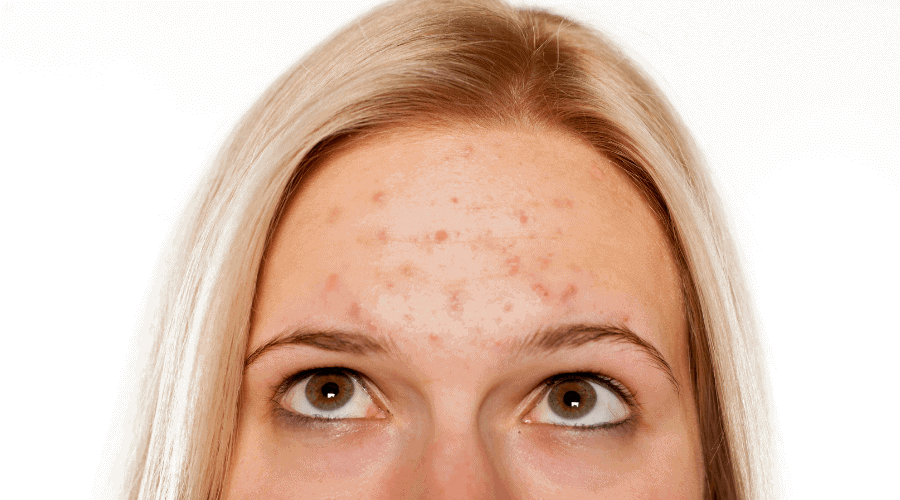
How Genes Influence Your Risk For Acne

How Does Genetics Influence Your Risk For Egg Allergy?
https://www.medicalnewstoday.com/articles/does-progesterone-cause-acne
https://www.medicalnewstoday.com/articles/320445
https://www.healthline.com/nutrition/foods-that-cause-acne
https://www.ncbi.nlm.nih.gov/pmc/articles/PMC4391699
https://www.ncbi.nlm.nih.gov/pmc/articles/PMC10111601
https://www.healthline.com/nutrition/elimination-diet
https://www.healthline.com/health/anti-acne-diet
Need to log in to your Nebula Genomics account but can't figure out how? Our step-by-step guide will help you sign in to the website in three easy steps. Once you access your dashboard, you can explore the services that Nebula has to offer.
Accessing your Nebula Genomics login is simple. Follow these steps to get started:

3. Click submit, and you should be able to access the account
Don’t worry; resetting your Nebula Genomics login credentials is easy.
Click on the “Forgot Password” button.

From here, in 3 easy steps, you can reset your password and recover your Nebula Genomics account.
If you do not have an account with Nebula Genomics, you can create an account by clicking on the “Sign Up For Free” link.

Follow these steps to create a free account:

6. Nebula will send a verification email - click on the confirm button in the email.
7. Your account will be created, and you’ll be redirected to your account dashboard.
Xcode Life's Genome Pack - $199 70% OFF
The Genome Pack includes Gene Nutrition, Gene Fitness, Gene Skin, Traits and Personality, Gene Sleep, MTHFR and Methylation, Gene Health, Gene Allergy, BRCA and Breast Cancer, and Personalized Medicine reports + FREE Caffeine Report
*exclusively for people who have already taken a DNA test. no DNA kits sold
Nebula Genomics offers DNA testing services focusing on whole genome sequencing, which provides a detailed analysis of a person's genetic makeup.
They offer reports that cover ancestry, genetic traits, and health insights.
Here’s a breakdown of their key products and services:
1. Whole-genome sequencing: Nebula Genomics focuses on sequencing 100% of your DNA, providing in-depth insights.
2. Ancestry reports: Their reports give users information about their ancestry, including regional breakdowns and potential connections to ancient populations.
3. Health insights: Nebula offers reports that assess genetic predispositions to certain conditions, physical traits, and wellness suggestions.
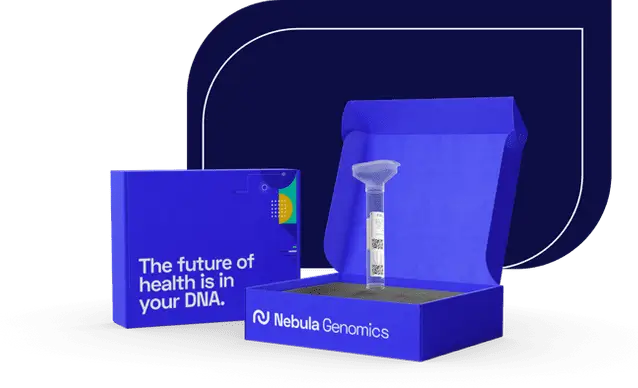
Nebula Genomics’ pricing model typically includes:
They occasionally offer discounts, so pricing may vary.
Nebula Genomics offers ancestry analysis through its deep genetic ancestry service, which utilizes whole genome sequencing. However, it primarily collaborates with external programs like Eurogenes and YFull for detailed ancestry insights.
The cost of Nebula Genomics' whole genome sequencing (WGS) starts at $249 and goes up to $999. Additionally, a membership fee is required for accessing personalized reports and tools.
The company, founded by Harvard professor George Church, emphasizes privacy and data security, utilizing blockchain technology to anonymize genetic data. However, some users have reported inconsistencies in raw data analysis, so it's advisable to approach results cautiously and verify findings through additional research.
One Reddit user writes, "Nebula has given me answers to health issues that none of my doctors have been able to figure out."
On the other hand, several Trustpilot users have opened up about delays in receiving their orders, with one user writing, "One year later and never got my results. Nebula ... have not corrected this problem."
| Feature | Invitae | Nebula Genomics |
| Focus | Genetic testing for inherited conditions | Whole genome sequencing and health insights |
| Order process | Through a practitioner | Consumer can directly order |
| Ancestry analysis | Limited ancestry information | Collaborates with external services for ancestry |
| Pricing | $250 - $450 (insurance coverage available) | $249 - $999 |
| Data privacy | HIPPA compliance, consent, CLIA - CAP verified, de-identification of data | Blockchain and encryption, limited third party access |
Nebula Genomics is not free, but users can upload raw DNA data from other services at no cost. The primary offerings, including whole genome sequencing and access to detailed reports, require payment.
Sequencing with Nebula Genomics typically takes 4-8 weeks after sample submission. However, some users have reported longer wait times due to various factors, such as demand and processing capabilities. They usually provide regular updates on progress through their platform.
Hormonal imbalance is a concept thought to occur most often in females. But did you know that males are also prone to a decrease in testosterone, the male sex hormone? Male hypogonadism is a condition where one’s testicles do not produce adequate amounts of testosterone. It affects libido, sperm count, and sexual ability. Left unchecked, it can affect mental health. What causes low testosterone? Is low testosterone genetic? Let’s find out more in this blog!
Low testosterone or male hypogonadism can be of two types-
A medical professional can determine the cause of hypogonadism and recommend a suitable treatment plan.
The usual range of testosterone (recorded in the morning) is generally 300-1000 nanograms per deciliter (ng/dL).
An individual is diagnosed with hypogonadism if their morning testosterone levels are <300 ng/dL on at least two occasions.
It is important to note that testosterone levels change with age.
The average elderly male has between 500 and 800ng/dL, whereas younger adults can expect a value between 600 and 900.
In addition to the testosterone levels, the doctor also evaluates concurrent symptoms that may indicate hypogonadism before diagnosing the condition.
Here are a few common symptoms of low testosterone:
There are several possible causes of low testosterone.
Causes Of Primary Hypogonadism
This kind of hypogonadism occurs when an inherent problem prevents the testicles from producing adequate amounts of testosterone.
Some conditions that could lead to primary hypogonadism are:
In addition to these genetic causes of low testosterone, other acquired causes include:
Causes Of Secondary Hypogonadism
As the name suggests, this type of hypogonadism occurs secondary to other conditions as a side effect.
Some of these conditions include:
Most males experience lower testosterone levels as they age.
However, certain health conditions, genetic changes, and medications can also cause low testosterone in men.

In addition to the causes of low testosterone mentioned above, there is a strong genetic link that may cause the condition.
Substantial evidence suggests abnormal gene changes (mutations) may affect testosterone levels.
Several genes have been identified that may increase the risk for low testosterone in males.
A 2021 study identified 114 new genetic markers that can assist doctors in determining the chances of males developing low testosterone in adulthood.
However, low testosterone is not considered a genetic condition.
Low testosterone is a common side effect of some genetic disorders, especially those that target the sex chromosomes.
This is a condition in which someone assigned male at birth has an extra copy of the X chromosome (XXY) instead of the usual XY.
It is a prenatal genetic condition but is not usually diagnosed until adulthood.
Klinefelter syndrome affects testicular growth, resulting in smaller testicles.
In turn, shrunken testicles produce very little testosterone and sperm.
Assisted reproductive technologies (ART) can help people with Klinefelter’s to have children naturally.
This syndrome is characterized by delayed or absent puberty.
It is a type of hypogonadotropic hypogonadism, meaning it affects the production, release, and effect of hormones that promote sexual development.
People born with Kallmann syndrome are born with a small penis and undescended testes.
Therefore, these individuals produce little or no testosterone and have delayed or absent puberty.
Some causes of low testosterone are heritable.
People with a family history of low testosterone may be at a heightened risk of developing the condition.
Different genetic conditions that cause male hypogonadism have different inheritance patterns.
Some may be dominant, meaning you will inherit the condition if one parent has it.
Others could be recessive, meaning you can only inherit the condition if both parents have it.
X-linked inheritance is more complex, determined by your mother’s carrier status and whether or not your father carries the gene for that condition.
Rena Malik, MD, is a board-certified urologist with specialized training in Female Pelvic Medicine, Reconstructive Surgery, and Sexual Medicine.
She explains why measuring testosterone in the morning is essential, saying, “Among men with traditional sleep patterns… ..your peak testosterone values occur between 3 and 8 AM. They’ve looked at total testosterone levels at 4 PM… and found that they’re 20-25% lower than measurements taken at 8 AM.”
If your doctor suspects low testosterone, they will perform a physical examination and recommend a few tests to determine the level of:
Low testosterone is treated using testosterone replacement therapy.
It is available in different forms, such as:
While testosterone therapy is routinely performed in males with low levels of the hormone, it does carry some risk.
A small number of males may experience the following risks of testosterone therapy:
Depending on your overall health and the presence of other comorbidities, your doctor will determine if you are a candidate for testosterone therapy.
In many cases, testosterone replacement therapy can help restore the levels of the hormone in the affected individual.
If the low testosterone is due to genetic or congenital causes, a one-time fix may not work.
If the low testosterone is due to modifiable factors like medications or poor lifestyle, making the required changes can help restore normal testosterone levels.
In addition to genetic changes, a poor lifestyle can lower testosterone levels.
Here are a few ways to increase your testosterone levels naturally:
Low testosterone affects 15% of subfertile males (males with lower fertility), but it does not have a direct link to fertility.
Studies have shown that having low testosterone does not impact semen volume, sperm count, motility, or other fertility parameters.
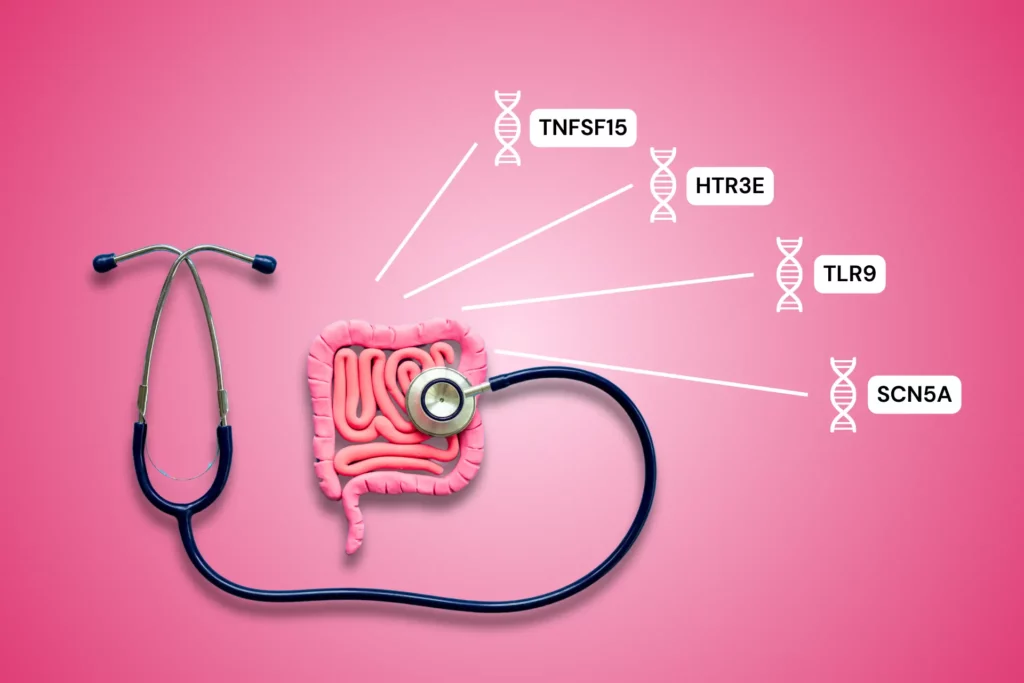
Is Irritable Bowel Syndrome (IBS) Hereditary? What Is Your Genetic Risk

Are Thick Eyebrows Genetic?

Is Flexibility Genetic?